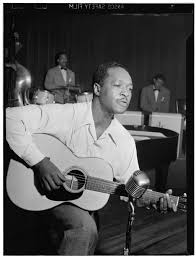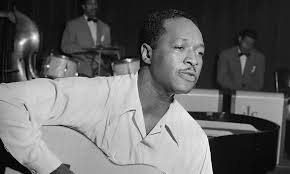Josh White – A Complete Biography
Introduction
Josh White (1914–1969) was a pathbreaking blues and folk singer-guitarist whose supple tenor voice, crisp Piedmont-style guitar runs, and fearless topical repertoire helped move Black American music from Southern street corners to Broadway stages, integrated nightclubs, radio, and even the White House. He became one of the first Black male solo artists to achieve mainstream celebrity in the 1940s, bridging spirituals, blues, cabaret, and protest songs, while mentoring or influencing later figures such as Pete Seeger and Harry Belafonte. His career also mirrored the tensions of mid-20th-century America: wartime anti-racist anthems, postwar acclaim, blacklisting during the Red Scare, and a late-career revival that kept him touring until his death.

Childhood
Joshua Daniel White was born February 11, 1914, in Greenville, South Carolina, to Dennis White, a tailor and lay minister, and Daisy Elizabeth White, who played autoharp. He sang in the church choir as a boy and grew up in a deeply religious household. A formative trauma marked his childhood: after Dennis White resisted a white bill collector, he was beaten by police and institutionalized, leaving young Josh to help support the family. This early hardship shaped both his social conscience and his later interest in music as a means of survival and expression.
Youth
Before he was ten, White left home as a “lead boy” guiding blind street and blues singers across the South, collecting coins after performances and learning an extensive repertoire of songs. By his mid-teens he was recording in Chicago, cutting sides for Paramount and later for ARC in New York. His sacred records were issued as “Joshua White, the Singing Christian,” while his blues appeared under stage names like Pinewood Tom and Tippy Barton—an early demonstration of his versatility. A serious hand injury in the 1930s threatened his career, but he retrained and returned with a distinctive, ringing guitar style.
Adulthood
By 1940 White had landed on Broadway in John Henry with Paul Robeson, and soon became a headliner at New York’s Café Society, the nation’s first integrated nightclub. With his striking looks, refined stage presence, and smooth tenor voice, he became a favorite among both Black and white audiences. He collaborated with folk musicians such as Lead Belly and Woody Guthrie, performed on Alan Lomax’s radio program Back Where I Come From, and even sang for President Franklin Roosevelt.
During World War II he recorded songs that addressed democracy, segregation, and civil rights, helping to popularize topical folk-blues in urban, interracial circles. But the postwar years brought political challenges. Listed in the anti-Communist pamphlet Red Channels, White testified before the House Un-American Activities Committee in 1950, affirming his patriotism while distancing himself from radical politics. Though this allowed him to avoid some of the harsher consequences of blacklisting, it damaged his reputation and narrowed his professional opportunities.
His comeback began in the mid-1950s with new recordings on the Elektra label, including the 25th Anniversary Album, which introduced him to a younger folk audience. Through the 1960s he toured extensively, recorded prolifically, and co-authored a guitar method book with Ivor Mairants. Despite increasing health problems, he remained active on the concert stage and on college campuses.
Major Compositions (Signature Songs and Recordings)
White’s career produced a remarkable repertoire that blended blues tradition with polished showmanship and political conscience:
- “One Meat Ball” (1944) — a witty, empathetic ballad about poverty, it became the first million-selling record by a Black male solo artist.
- “The House I Live In” — a patriotic hymn to American pluralism, recorded during the 1940s.
- Protest songs — including “Free and Equal Blues,” “Jim Crow Train,” “Bad Housing Blues,” and “Uncle Sam Says,” all of which confronted segregation, injustice, and wartime hypocrisy.
- Traditional standards — such as “House of the Rising Sun,” “St. James Infirmary,” and “John Henry,” which he delivered with clear vibrato and precise Piedmont fingerpicking, inspiring later folk-revival performers.
Death
Josh White’s career was cut short by chronic illness, including heart disease and emphysema. He underwent valve-replacement surgery in Manhasset, New York, but died on September 5, 1969, at the age of 55. He was buried at Cypress Hills Cemetery in Brooklyn. His passing was widely mourned, and obituaries noted both his pioneering artistry and his courage in confronting the racial and political realities of his era.
Conclusion
Josh White’s life defied simple categories. A child guide to blind bluesmen who became a sophisticated nightclub star; a church singer who recorded uncompromising protest songs; a celebrity welcomed at the White House who also endured blacklisting—his career encapsulated the contradictions of mid-century America. His elegant guitar technique and expressive voice opened new pathways for African American music in mainstream culture, while his topical songs kept social justice at the heart of his work. Today, White is remembered as a crucial link between the early blues, the folk revival, and the ongoing struggle for dignity and equality in American music.

Comments are closed